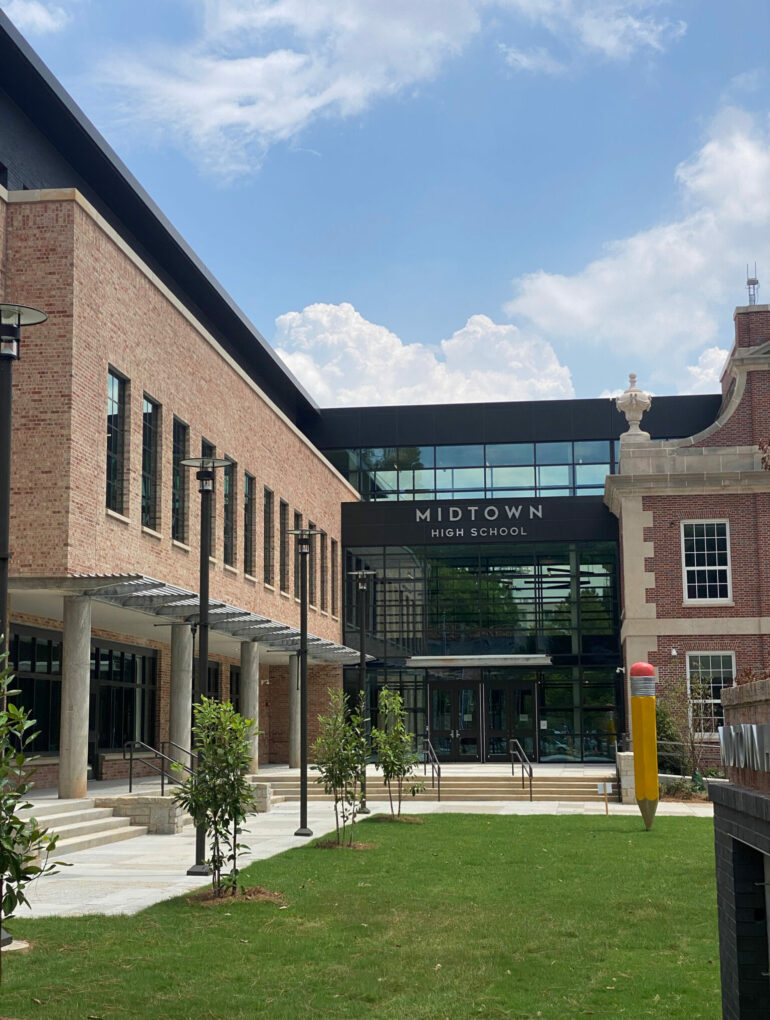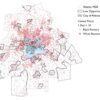Karen Cook, then pursuing a master’s degree in Anthropology at Georgia State University, delved into the topic of school redistricting in her dissertation titled Atlanta Public Schools Case Study: A Tale of Two Schools. While Cook’s research is over a decade old, ongoing public school redistricting policies continue to affect APS students even today. As Atlanta’s students continue to navigate the implications of such policies, Cook’s insights into successful community movements stand as valuable guides.
On March 24th, nearly 200 students from Midtown High School marched in protest of rezoning plans set forth by the APS board. Earlier in the school year, the school board had sent out a survey to affected families, proposing two solutions to counter overcrowding issues at Midtown High School. The first option included strategies to redesign and improve the school without relocating any of its current students. The second was far more controversial – it required rezoning Midtown students to Washington High School, a less populated and under-resourced school about six miles away. Students were enraged. Many felt that the plan targeted black students, isolating them from Midtown’s higher-quality resources and making the school increasingly segregated and less diverse. Students were also shocked by the board’s indifference to their concerns. The @midtown_protest2023 Instagram page claimed that while Superintendent Dr. Herring had promised to meet individually with students during a school visit, she ultimately refused to speak to them. Adding to the frustration, a formal complaint online form was found to be faulty, leading users to a non-existent 404 page and giving them no option to voice their opinions.
The issue of school redistricting is far from new. Back in 2013, a similar scandal unfolded in numerous middle schools, culminating in a series of school closures by APS. Karen Cook, then pursuing a master’s degree in Anthropology at Georgia State University, delved into this topic for her dissertation titled Atlanta Public Schools Case Study: A Tale of Two Schools. Interested in the planning process that went into selecting schools slated for closure, she examined the causes and effects of redistricting, what it takes for a community to successfully save its schools, and the extent to which race and social class play in the redistricting process. Cook’s research centered on two middle schools: D.H. Stanton, successfully preserved in the Peoplestown community, and Kennedy Middle School in Vine City, which, regrettably, was forced to close. By utilizing an interview-focused approach, she hoped to use her study to give a voice to minority educators, parents, and community members who fought to save their local schools, all while providing valuable insights to future generations in a similar situation.
Much like the present concerns raised by Midtown students, Karen Cook recognized that black and minority students were disproportionately displaced and sent to under-resourced schools. While predominantly black schools on the south and west sides of town were being closed, increased funding was given to schools in upscale, northern parts of the city, such as Buckhead. Similarly, students from Midtown were reluctant to switch to Washington High School due to the disproportionate graduation rates (Midtown boasting a strong 90%, and Washington a mere 70%) and the effect this might have on their future. This trend reveals how the APS board seems to be trying to relocate black and minority students to schools that receive less funding and resources; some have gone as far as to call this “re-segregation”.


After a significant uproar on behalf of their school, the community of Peoplestown successfully managed to save their local middle school. Nevertheless, quite a few external factors played a part in their success, and their lack thereof led to Kennedy’s downfall. The first was a robust external support system. Most schools that fought back successfully relied heavily on this factor. For instance, Stanton was backed by the Emmaus House and its Vicar, Reverend Jones.
Similarly, Coan Middle School, which was also saved from closing, was backed by Provost Earl Lewis from Emory University. These endorsements elevated the middle schools in the eyes of APS board members, giving them “a voice, prestige and capital”. Unfortunately, while Kennedy was located a few blocks away from large institutions such as Clark Atlanta or Spelman College, none of these schools stepped in to help. Had they done so, Kennedy Middle School might still be up and running today.
In Peoplestown, neighbors came together to successfully form a resilient, well-organized community that supported their middle school in crisis. Despite being given short notice of the school’s impending closure, Dr. Clara Taylor, the interim principal who pulled the school out of its previous rut, used her welcoming approach and an open-door policy to incentivize the community to rally in support of the school. In a newsletter from October of 2012, her enthusiasm and dedication to her role shine through as she emphasizes the importance for students to “arrive early enough to have breakfast and be in class by 8:00 a.m.” and updates parents on new developments at the middle school. Such a strong and dedicated leader helped inspire the community, underscoring the necessity of leadership during difficult times.
On the contrary, Kennedy Middle School was far less lucky in organizing community support. The school’s board of leaders was less willing to work alongside their community and failed to provide them with the necessary information, upsetting many parents who felt that their chance to fight had been stripped from them.
“To get people to participate you’ve got to give people at least a two-week notice so they can take off from work to support the school (…) if the superintendent knew a month in advance he should have prepared us a month in advance and at least given us a chance to fight. We didn’t have a chance to fight,” complained a Kennedy parent.

Some were also skeptical about the true motives of the APS board, as they suspected that the school board had other financial motives to close the school, such as using the newly freed land in Vine City to build increased parking to support the new Falcons stadium. Such tardy information and blatant lack of effort from the school board made parents feel “powerless to fight against ‘downtown.’” Many felt manipulated by the APS board and lost all urge to fight.
Kennedy’s closure had far-reaching repercussions, with students struggling to grapple with losing their school community. The scene at Brown Middle School was also discouraging. With tensions due to overcrowding and violent altercations between students from different districts, the school often had to go into lockdown to handle such crises. Comparable challenges emerged in other schools facing closures, such as Midtown. The disruption caused by longer commutes and the loss of academic resources underscored students’ anxieties.
On the bright side, the Peoplestown community succeeded in saving their school and continued to work together to pull the school out of its previous rut and make it an empowering community for its students. “Not only did we stay open but there’s actual, visible growth,” a community member proudly notes. The community has been working hard to establish a turnaround plan to increase academic success and build students’ leadership abilities. For instance, Dr. Clara Taylor and William Teasley, a Peoplestown resident, worked to implement a Leader in Me program, making Peoplestown the first school within the APS system to try it out. This program emphasizes a culture of student empowerment that helps to unleash each child’s full potential, centered around the “Seven Habits of Highly Effective People” philosophy of the late Stephen R. Covey. Various other improvements, such as a new playground, a Girl Scouts program, and impressive partnership programs with corporations such as AT&T, have proven the community’s ability to take matters into their own hands and strengthen their school.
Thanks to research like Cooks’, communities are now equipped with concrete and practical steps to help them fight against rezoning policies. Midtown’s recent peaceful protest is an example of recent improvement; they successfully managed to pressure the APS board to eliminate its rezoning option, opting instead to implement a five-month-long strategizing plan to improve the school’s facilities and adapt them to the increasing student body.
While Cook’s research is over a decade old, ongoing public school redistricting policies continue to affect APS students even today. As Atlanta’s students continue to navigate the implications of such policies, Cook’s insights into successful community movements stand as valuable guides. With her findings, there can be more success stories similar to Midtown High School as communities learn to come together and use tools such as social media, peaceful protests, and impactful leaders to make their opinions heard.
Celine Chauviere is a sophomore at Cornell University, pursuing a degree in Industrial and Labor Relations. After spending her first year at Emory University, she developed a strong interest in the intersections between education and public policy, particularly regarding how inequalities in education can lead to different economic outcomes in American Society. She can be reached at coc22@cornell.edu.
Citation: Chauviere, Celine. “Redistricting in Atlanta: The impact of Race, Class, and Community Involvement in the Face of School Closures.” Atlanta Studies. November 22, 2023. https://doi.org/10.18737/atls20231122.
Works Cited
Atlanta Public Schools drops redistricting plans after student protest. (n.d.). Retrieved August 22, 2023, from https://www.ajc.com/education/atlanta-public-schools-drops-redistricting-plans-after-student-protest/YMHIACIANFGYJJJ2RXOMCWC7YA/
Clara Taylor Named Permanent Principal at D.H. Stanton Elementary. (2013, January 22). East Atlanta, GA Patch. https://patch.com/georgia/eastatlanta/taylor-named-permanent-principal-at-d-h-stanton-elementary
Cook, K. (n.d.). Atlanta Public Schools (APS) Case Study: A Tale of Two Schools. https://doi.org/10.57709/4315505
Dalton, M. (n.d.). Atlanta Public Schools drops redistricting plans after student protest. The Atlanta Journal-Constitution.
‘It’s re-segregation, honestly:’ More than 200 Midtown HS students walk out over rezoning plan – WSB-TV Channel 2—Atlanta. (n.d.). Retrieved August 22, 2023, from https://www.wsbtv.com/news/local/over-200-high-school-students-walk-out-protesting-proposed-rezoning-plan/CGZDL6JIPJC65OB7QIYBNYAMHY/
Midtown H.S. Students walkout to protest over possible school rezoning—CW Atlanta. (n.d.). Retrieved August 22, 2023, from https://www.cbsnews.com/atlanta/news/midtown-h-s-students-walkout-to-protest-over-possible-school-rezoning/
Strauss, V. (2022a, February 1). Perspective | Remember the Atlanta schools’ cheating scandal? It isn’t over. Washington Post. https://www.washingtonpost.com/education/2022/02/01/atlanta-cheating-schools-scandal-teachers/
Strauss, V. (2022b, February 1). Perspective | Remember the Atlanta schools’ cheating scandal? It isn’t over. Washington Post. https://www.washingtonpost.com/education/2022/02/01/atlanta-cheating-schools-scandal-teachers/




